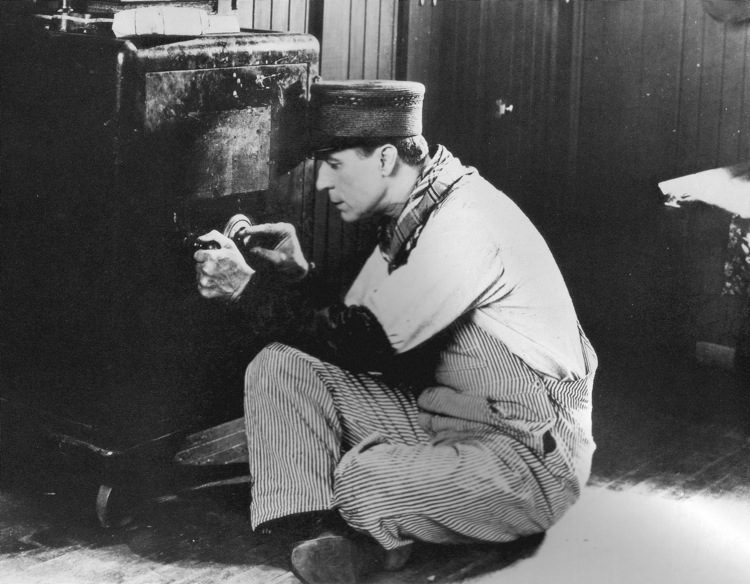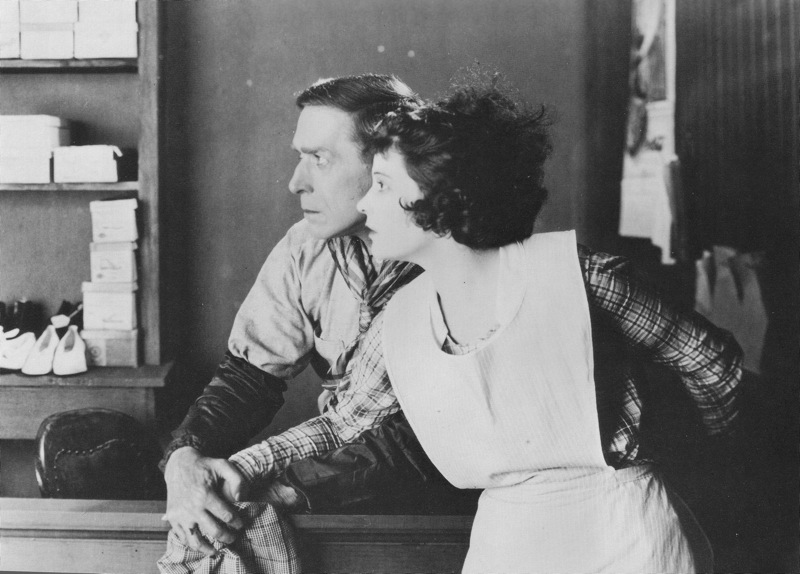 Every other week, we seem to get a new lament about the End of Cinema. Usually, the blame falls on modern Hollywood and its infantilizing comic book movies. Never before in the history of movies, claims David Denby in The New Republic, was so much attention and capital devoted to an endless succession of sequels aimed at ten-year-old boys. The eight-decade reign of Adult Movies is a distant memory.
Every other week, we seem to get a new lament about the End of Cinema. Usually, the blame falls on modern Hollywood and its infantilizing comic book movies. Never before in the history of movies, claims David Denby in The New Republic, was so much attention and capital devoted to an endless succession of sequels aimed at ten-year-old boys. The eight-decade reign of Adult Movies is a distant memory.
There’s no denying that Disney allocated unfathomable sums to The Avengers, but Hollywood did not become an adolescent assembly-line overnight. Indeed, these industry-wide ambitions stretch back decades. King Kong premiered in March 1933 and RKO managed to release runt follow-up Son of Kong by year’s end. Columns devoted to the lasting eloquence of classic-era adult product like Jezebel rarely acknowledge that these special films existed alongside interminable series pictures aimed squarely at the kiddie matinee trade. A prolific modern franchise like Saw yielded seven entries between 2003 and 2010; by comparison, audiences were treated to no less than forty-eight Bowery Boys features between 1946 and 1958. (Some might suggest that this is a false equivalence, as the average Bowery Boys outing imparts crisper moral education than the torture porn of Saw. These folks have never sat through an entire Bowery Boys movie.)
We cull film history for isolated masterpieces, but the trajectory of the medium can probably be understood better through the typical, repetitive junk that provided producers with steady, safe returns. Sometimes, this product can even intersect with real art.
 The films of William S. Hart provide a compelling test case. They’re hardly junk, but even Hart’s partisans must acknowledge that they are repetitive. See them singly over a number of years and each looks like a revelation. Watch a few in quick succession, and the limitations of Hart’s interests and strategies become immediately evident.
The films of William S. Hart provide a compelling test case. They’re hardly junk, but even Hart’s partisans must acknowledge that they are repetitive. See them singly over a number of years and each looks like a revelation. Watch a few in quick succession, and the limitations of Hart’s interests and strategies become immediately evident.
Always Hart played the good-bad man and always he glimpsed redemption in an innocent maid. The hostility at the core of civic society never abated. (The exceptions proved the rule: Hart’s deviations from his established screen persona courted instant absurdity, such as his turn as an Aztec chieftain in 1916’s The Captive God.)
This is not a wholly retrospective observation. In 1920, Carl Sandburg reviewed Hart’s latest, Staking His Life, in familiar terms for the Chicago Daily News:
The ingenuity of the studio group surrounding Bill Hart brings fresh admiration with this film. Haven’t they been showing him now for years riding horses, gambling, shooting, getting religion, making sacrifices? And wouldn’t we almost think soon they would run out of fresh plots and fresh air and the wild west would go a little stale? Yes, naturally we might presume just such circumstances. But it would be presumptuous on our part.
These studio workers around Bill Hart seem to be what on Dorchester Avenue they call indefatigable. They either give new stuff entirely, or if they use old stuff they make it more refreshingly antique.
This was not only an American sentiment. If anything, French enthusiasm for Hart—known in Gallic circles as “Rio Jim”—was even greater. Consider Louis Delluc’s review of The Cold Deck from a 1919 issue of Paris-midi:
William Hart, the popular Rio Jim, is the tragedian of the cinema. He mounts a horse like Mounet-Sully descends a staircase….
In his domain, William Hart has the same godlike serenity and the same violent ways. He is no ordinary cowboy of the circus or of a thousand and one dashed-off films. He is the synthesis of that plastic beauty which marks the schematic and almost stylized Far West. Transcending the specific details of his characters, William Hart reveals a profoundness of spirit. They used to call him “the man from nowhere.” What a lovely title! We never know where Rio Jim comes from. He just passes through. He crosses the West—and the West is so huge. He arrives on horseback. He leaps down onto the ground where other men live. Generally, the time that he remains there is devoted to suffering, that is, to loving ….
Never has William Hart been so nobly tragic and so simply grandiose. He emerges in the milieu of the usual crowds and decors of this stylized Far West of the cinema, where the splendid fatalism of Sophocles comes alive for us—but it is still too early to say whether the cinema will have as intense a presence as the great Greek spectacles which whole people attended.
With his 1921 essay “From Orestes to Rio Jim,” Delluc settled this question once and for all. “Aeschylus did not create Prometheus on purpose,” concluded Delluc, “it was forced on him. Rio Jim is the advance guard of the coming great film figures.”
 If Hart’s films endure, credit must go to the durability of the craft. Watch almost any Hart film and you’re bound to come away impressed with Joseph August’s top-notch photography, a dusty recall of reanimated frontiers. The efficiency and emotional coherence of the staging is also notable, on par with the complex work seen in such contemporary European imports as Victor Sjöström’s Ingeborg Holm. The art titles possess an undeniable graphic beauty, too, enriching and commenting upon the action on-screen. And, of course, we have the immobile but expressive Hart visage above all—a chiseled stoicism that somehow expressed boundless rage and enduring love with the very same tics.
If Hart’s films endure, credit must go to the durability of the craft. Watch almost any Hart film and you’re bound to come away impressed with Joseph August’s top-notch photography, a dusty recall of reanimated frontiers. The efficiency and emotional coherence of the staging is also notable, on par with the complex work seen in such contemporary European imports as Victor Sjöström’s Ingeborg Holm. The art titles possess an undeniable graphic beauty, too, enriching and commenting upon the action on-screen. And, of course, we have the immobile but expressive Hart visage above all—a chiseled stoicism that somehow expressed boundless rage and enduring love with the very same tics.
These virtues were not Hart’s alone, but few others insisted upon them with such consistency. The Hart pictures were a brand and a very reliable one for millions of fans.
Yet as technically impressive as many Hart films were and remain, their distinguishing feature lies elsewhere. As Diane Koszarski has observed, “Hart’s characteristic signature as an auteur is the glowing moral intensity of his films; it glimmers fitfully even in a light-hearted piece like Branding Broadway and bursts in apocalyptic glory in Hell’s Hinges and Selfish Yates. No Western stars of his time or later could match Hart’s fundamentalist grandeur (or particularly cared to).”
The Hart films are fiery sermons with no patience for extenuating circumstances or question-begging. He’s a frontier preacher with only one lesson, delivered with slightly different inflections and citations each week. Even more so than his contemporary D.W. Griffith, Hart strives to “show the dark side of wrong, that we may illuminate the bright side of virtue.”
If we don’t share Hart’s strain of Victorian-Calvinist conservatism, why should we treat the consistency of these themes as a virtue? This is a difficult question, not least because it embodies a kind of sticky Eastern skepticism that Hart would likely meet with a sock to the jaw. One answer might go something like this:
Hart’s screen career lasted a little over a decade, but those years saw a wholesale transformation of the movie industry that can be traced with extraordinary precision through Hart’s films. All bluster aside, Hart’s earliest screen endeavors really did represent a sort of frontier, before commercial moviemaking became regimented and standardized. The early Hart films, like The Disciple and Hell’s Hinges, give us 200-proof Hart—an artist encumbered only by the moral thicket of his own doubts and recriminations.
As the film industry organizes itself with increasing efficiency after 1917, Hart’s films doggedly try to hold on to their primal, artisanal fury. The films from the early 1920s are not entirely successful, but they are moving as artifacts of an ongoing, bodily struggle. Hart’s films had been formulaic, but they had been his formula. Hart’s absolutism had no need of subplots, auxiliary characters, or comic relief (they were distractions from an already-legible moral lesson) and his films strain mightily under the yolk of these impositions. The over-extended plot of White Oak (1921) meanders indifferently. Hart’s final feature, Tumbleweeds (1925) tries to imitate the epic, multi-character mode of The Covered Wagon but plays like a pre-digested spectacle, ambitious but resigned. It’s a sermon with a circus built up all around it.
That Hart persisted in his strident evangelism from the maw of the nascent studio system is not heroic, per se, but it’s notable when most Hollywood features from the period were so shorn of rough edges and personal conviction. Hart’s films offer us invaluable insight into American cinema, religion, geography, and industry in brief, brittle concert.
The Northwest Chicago Film Society screens William S. Hart’s 1920 feature Sand in an archival 35mm print from the Library of Congress on Wednesday, November 14 at the Portage Theater. Jay Warren will provide live organ accompaniment. Special thanks to Rob Stone and Lynanne Schweighofer. For more information, please see our current schedule.

